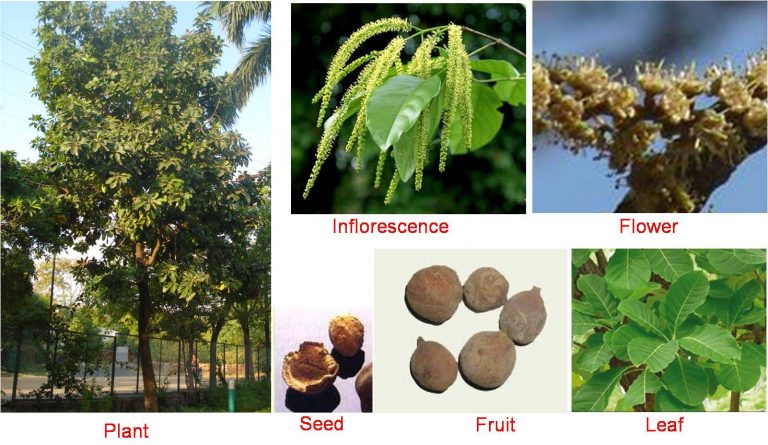VIBHITAKI
- Home / DRAVYAGUNA (AYURVEDIC PHARMACOLOGY) / / KNOW ABOUT MEDICINAL PLANTS / / AYURVEDIC MEDICINAL PLANTS /
- VIBHITAKI
Vibhitaki a important plant whose fruits are used as a medicinal one along with the fruits Amalaki (Indian Gooseberry) and Haritaki (Chebulic myrobalan) in the system of Ayurveda. The trio forms the most famous Triphala which is known worldwide today for its varied and multiple benefits. As such the fruits of the plant are basically very much used for the purpose of providing black colour to the hairs, tanning of leather, etc. The Botanical name of this important plant is Terminalia bellirica (Gaertn) Roxb. belonging to Combretaceae family. Here the word “Terminalia” means that which produces from the extremities. Especially the leaves and fruits are seen in the extreme point of the branches. The word “bellirica” stands for the word “Beley” which is an arabic name of Bibheetaki.
PLANT DETAILS
BOTANICAL NAME
Terminalia bellirica (Gaertn) Roxb
FAMILY
Combretaceae
NOMENCLATURE
VERNACULAR NAMES
- Kannada – Tarekayi or Shantikayi
- Malayalam – Thaani
- Tamil – Tandri
- Telugu – Tani
- Hindi – Bahed
- English – Belleric myrobalan
SANSKRIT SYNONYMS
- अमृत (Amruta) – Is beneficial like nectar and postpones ageing
- धात्री (Dhatri) – is mother or foster-mother in Sanskrit. Hence the fruit takes care of us like mother
- श्रीफल (Shriphala) – Highly beneficial fruit
- शीत (Sheeta) – Has a soothing potency
- त्रिष्यफल (Tishyaphala) – The fruit is demarcated with three lines
- आमलक (Amalaka) – A sour tasting fruit
- शिव (Shiva) – A very auspicious and favourable
SAMHITA CLASSIFICATION
- Charaka Samhita – वयस्थापन (Vayasthapana) & विरेचनोपग (Virechanopaga).
- Sushruta Samhita – त्रिफल (Triphala) & परूषकादि (Parushakadi).
NIGHANTU CLASSIFICATION
- Dhanvantari Nighantu – Chandanadi Varga
- Bhavaprakasha Nighantu – Hareetakyadi Varga
- Raja Nighantu – Amradi Varga
- Kaiyadeva Nighantu – Aushadhi Varga
BRIEF MORPHOLOGY
NOT YET COMPILED
PHARMACOGNOSY OF OFFICIAL PART
MACROSCOPY
YET TO BE COMPILED
MICROSCOPY
YET TO BE COMPILED
PART USED AND POSOLOGY
PART USED
NOT YET COMPILED
DOSE
NOT YET COMPILED
PHYTOCHEMISTRY
NOT YET COMPILED
रसपञ्चक कर्म PROPERTIES AND USES AS PER AYURVEDA
गुण (Properties)
- रस (Rasa) – )
- गुण (Guna) – )
- वीर्य (Veerya) – )
- विपाक (Vipaka) – )
- प्रभाव –
कर्म & प्रयोग (Action & Indications)
- दोषकर्म (Doshakarma) – )
- धातुकर्म & मलकर्म (Dhatukarma and Malakarma) – ल ()
- Other Actions – )
- प्रयोग (Prayoga) – ग्न () )
AYURVEDIC FORMULATIONS
CLASSICAL
- NOT YET COMPILED
PROPRIETARY
- NOT YET COMPILED
AGRONOMY
ENVIRONMENT
NOT YET COMPILED
CULTIVATION
NOT YET COMPILED
HARVESTING
NOT YET COMPILED
STORAGE
NOT YET COMPILED
VARIETIES AND SUBSTITUTES OR ADULTERANTS
VARIETIES
General classification it is of two types namely
- वन्य (Wild)
- ग्राम्य (Cultivated)
ADULTERANTS
NO KNOWN ADULTERANTS
SUBSTITUTES
NO KNOWN SUBSTITUTES
TOXICITY
TOXIC SYMPTOMS
- As such there is no proved toxicity of the plant.
ANTIDOTE
- Not Applicable as such.
शोधन or PURIFICATION METHOD
- NOT NECESSARY
THERAPEUTIC USES
EXTERNAL USES –
NOT YET COMPILED
INTERNAL USES –
NOT YET COMPILED
CONTROVERSY (IF PRESENT)
YET TO BE COMPILED
LIST OF RESEARCH STUDIES
- NOT YET COMPILED
The video on Vibhitaki emphasises on the various aspects of the plant especially with respect to its cultivation and its characteristics for identification such that they are preserved for the future generations.



